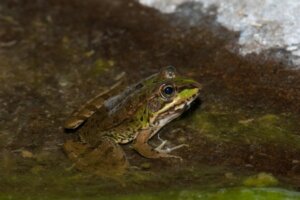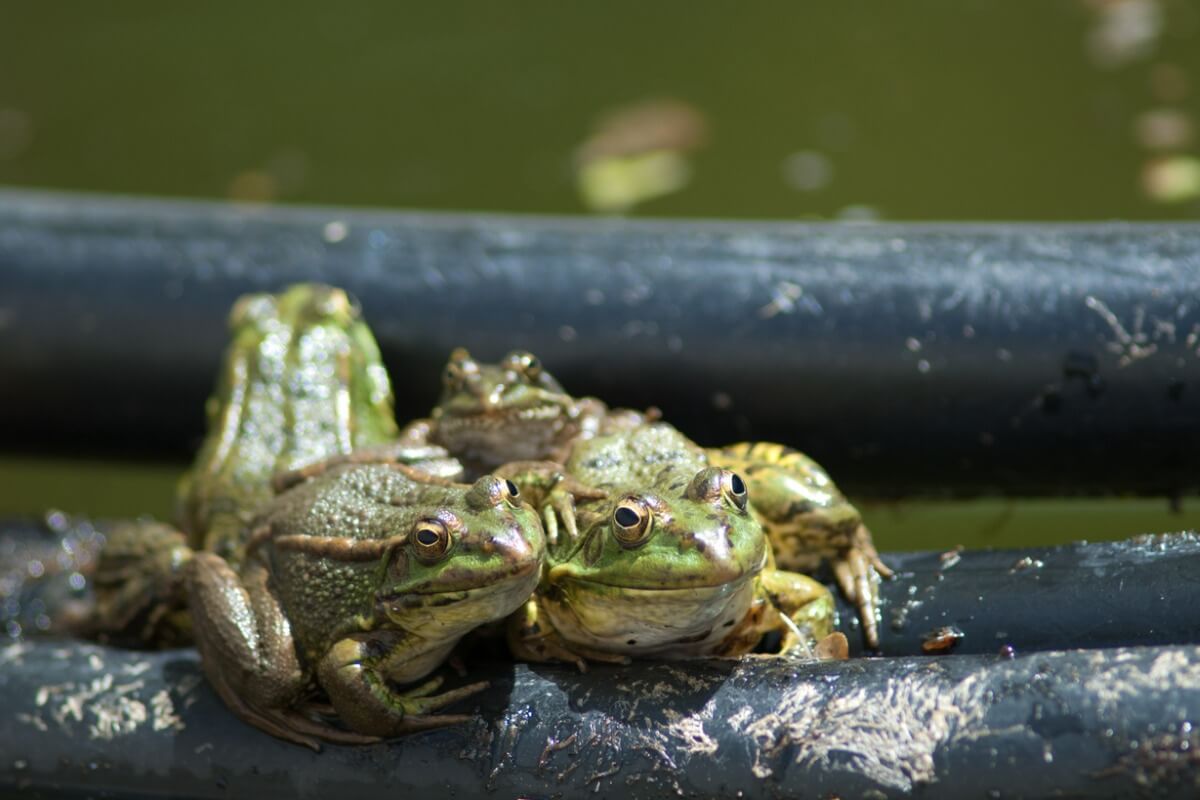Perez's Frog: Habitat and Characteristics


Written and verified by the biologist Samuel Sanchez
The Iberian Peninsula is one of the European regions with the most biodiversity, as it’s estimated that more than 60,000 species of animals proliferate in its different ecosystems. However, amphibians (class Amphibia) are very underrepresented in the Hispanic biocenosis, since only 32 of the 7500 species that exist have colonized these lands. Perez’s frog is one of them.
This friendly amphibian populates the ponds and other water bodies of the Mediterranean lands, making itself known with its strident song and sounds when jumping into the water during the summer. If you’d like to know more about Perez’s frog (Pelophylax perezi) and its biological cycle, you’re in the right place.
Habitat of the Perez’s frog
First of all, it’s necessary to emphasize that this species is endemic to the Iberian Peninsula and southern France. It has been introduced in the Canary Islands and the Balearic Islands, but these aren’t considered to be part of its original distribution range. It’s a very resistant and adaptable amphibian, and the proof of this is that it occupies all regions of Portugal and Spain without exception.
Altitude is the only limiting factor for its expansion (it doesn’t inhabit areas more than 2400 meters – 7900 feet – above sea level), and Perez’s frog isn’t hampered by adverse weather conditions. In any case, it’s a species with an eminently aquatic life cycle and it must always remain near water, and above all in permanent water bodies that don’t evaporate in summer.
This species withstands temperatures from 3° C to 30° C, 37 to 86 Fahrenheit

Physical characteristics
Before diving into the physiology of this species, we need to contextualize it at the taxonomic level. Perez’s frog is an anuran amphibian, which means it doesn’t have a tail. This is the biggest difference from its close relatives, such as newts and salamanders.
Like all anuran amphibians, this animal has bulging eyes, a fairly large mouth compared to its head, and very thin skin. This last attribute is vital for frogs, since the permeability of their epidermis allows them to carry out gas exchange and breathe passively. In some species, up to 100% of the oxygen received comes from skin respiration.
Specifically, Perez’s frog has a medium size, a rounded snout, and glandular folds on both sides of the back that go from the eyes to the cloaca. The forelimbs have 4 elongated toes, while the hind limbs have 5 webbed toes that facilitate swimming action and propulsion in the water.
The coloration of this species is usually greenish with black bands, although it’s highly variable between individuals and populations. In addition, males have very characteristic grayish vocal sacs, which swell when they sing to attract females.
These frogs are usually greenish or brownish on the back, while on the ventral part they have a cinnamon hue.
The behavior of Perez’s frog
As we’ve said, this amphibian is much more aquatic than some of its relatives. The specimens are always in or near the water, so it’s very common to see them in water holes, ponds, fountains, and lagoons. They can also be found in steep streams and cold bodies of water, although this isn’t their preference.
As indicated by the Iberian Vertebrates portal, this species is active throughout the year, although its activity decreases drastically in winter. In addition, unlike other amphibians, it has a clear daytime activity, with a high activity phase between 11:00 and 16:00 hours of the day.
It’s common to see juveniles and adults sunbathing on the edges of water bodies, as they’re ectothermic animals that require environmental heat to regulate their metabolism. As soon as another living being approaches them, they dive quickly into the water and remain submerged for a time, at least until they perceive the threat has gone.
Perez’s frog feeding
All amphibians are strict carnivores and Perez’s frog is no exception. This species feeds on both aquatic and terrestrial prey, but generally hunts on land. It’s believed that more than 45% of its menu could be based on coleopterans, that is, beetles of small to medium size. It also feeds on spiders, isopods, worms, and any invertebrate that fits in its mouth.
As it’s a medium-sized frog (10 centimeters, or 4 inches), it can also sometimes prey on small vertebrates, such as baby birds and mice. It should be noted that the larvae or tadpoles feed on algae and debris present on marine beds.
Reproduction
The reproduction period of this species varies according to the population, as we must remember that it’s found throughout Spain and the climate is quite variable between regions. In any case, professional sources estimate that courtship and laying take place between April and July, especially in areas with permanent waters.
The most striking feature of the reproductive cycle of this species is the way males sing. As we have said, these have specialized vocal sacs, which swell when the specimen emits its tonality. In addition, the suitors are grouped into choirs of 2 to 6 copies and the intervals and frequencies of each sound are specific to the situation.
Once the female is conquered by a male’s song, he “hugs” her in an axillary “amplexus”, taking advantage of the calluses on her front legs to hold on to her partner. Then, the female releases 2,000 to 7,000 eggs into the water and the male releases his sperm on them, fertilizing them externally.
The tiny tadpoles take 5 to 8 days to hatch from the eggs and once they swim freely they begin to grow and develop, reaching sizes of even 6-7 centimeters (nearly 3 inches). When they have developed legs, the lungs have grown and the tail has been reabsorbed (about 10 weeks after being born), the small frogs venture onto the terrestrial environment for the first time.
Although the number of eggs that each female lays may sound enormous, we should point out that most of hatchlings never reach metamorphosis.
Conservation status
The International Union for Conservation of Nature (IUCN) lists this species as “of least concern (LC)”. It’s distributed throughout its original area, but, even so, its populations are decreasing markedly today. Like all other amphibians, Perez’s frog suffers the effects of pollution and climate change.
Unfortunately, the changes in the use of water and the modification of the terrain make this species lose the lagoons and water holes in which it lives and breeds. To all this, we must add the effects of chemical discharges on water, road accidents, and climate change, among many other things.
41% of the world’s amphibians are in danger of disappearing. It’s the group of vertebrates that suffers most due to human action
Unfortunately, the global outlook isn’t encouraging for amphibians. Even the hardiest species like Perez’s frog are noticing the effects of ecosystem depletion. It’s quite clear, then, that these beautiful and fragile animals need to be protected before it’s too late.
All cited sources were thoroughly reviewed by our team to ensure their quality, reliability, currency, and validity. The bibliography of this article was considered reliable and of academic or scientific accuracy.
- Pelophylax perezi, IUCN Red List. Recogido a 3 de septiembre en https://www.iucnredlist.org/species/58692/89704409
- Pelophylax perezi, Enciclopedia Virtual de los Vertebrados Españoles (CSIC). Recogido a 3 de septiembre en http://www.vertebradosibericos.org/anfibios/reproduccion/pelperre.html
- Egea-Serrano, A., Tejedo, M., & Torralva, M. (2009). Populational divergence in the impact of three nitrogenous compounds and their combination on larvae of the frog Pelophylax perezi (Seoane, 1885). Chemosphere, 76(7), 869-877.
This text is provided for informational purposes only and does not replace consultation with a professional. If in doubt, consult your specialist.